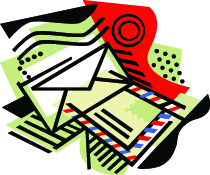 If you’ve been reading our most recent newsletters, you’ll notice a theme – that traditional direct mail, email, and social media work best together. All have their places in a marketer’s tool kit, they do not cancel the need for the others, and they may even work symbiotically as when a post card is sent offering a premium if the recipient provides an e-mail address or likes a social media site.
If you’ve been reading our most recent newsletters, you’ll notice a theme – that traditional direct mail, email, and social media work best together. All have their places in a marketer’s tool kit, they do not cancel the need for the others, and they may even work symbiotically as when a post card is sent offering a premium if the recipient provides an e-mail address or likes a social media site.
Some Audiences Prefer Traditional Direct Mail
While we acknowledge the growing importance of email and web-based communication to reach customers and prospects, computers and mobile wireless devices like smartphones cannot by themselves reach everyone in a business or organization’s target market. That could change as the use of mobile wireless devices spreads (which is happening rapidly), but until that time, traditional direct mail still has a valuable place as a marketing tool.
Traditional direct mail is a good choice for some audiences (such as an older demographic whose adoption of web-based communications may be lagging younger audiences) and for anyone who clearly states a preference for direct mail.
Traditional direct mail is also a good choice for businesses and organizations whose target audience is local. Sustaining membership campaigns, fundraisers, and financial support appeals by community-based non-profits are good examples where outreach by traditional direct mail to the homes of donors is likely to outperform email or web-based appeal.
Anticipating the addition of, or even the switch to web-based communication, businesses and organizations are collecting e-mail addresses and starting permission-based newsletters and blogs. But until that task is complete, traditional direct mail could be the only way to reach a customer or prospect.
More…
 If you are like most of our customers, you have a lot of questions about designing an effective direct mail marketing piece. Should you use a post card, a self-mailer, or an envelope? Use lots of copy or lots of white space? Announce who the mail is from or build the reader’s curiosity? With so many variables to consider, where does one begin to seek the right answers?
If you are like most of our customers, you have a lot of questions about designing an effective direct mail marketing piece. Should you use a post card, a self-mailer, or an envelope? Use lots of copy or lots of white space? Announce who the mail is from or build the reader’s curiosity? With so many variables to consider, where does one begin to seek the right answers?





 The time to begin an article is when you have finished it to your satisfaction. By that time you begin to clearly and logically perceive what it is you really want to say.
The time to begin an article is when you have finished it to your satisfaction. By that time you begin to clearly and logically perceive what it is you really want to say. “Postcards are the simplest, most cost-effective format available. They’re an excellent choice for making an announcement or driving customers to a store, website, or event.”
“Postcards are the simplest, most cost-effective format available. They’re an excellent choice for making an announcement or driving customers to a store, website, or event.”
